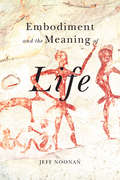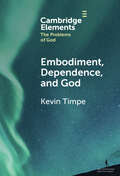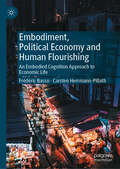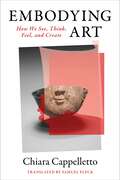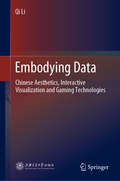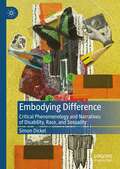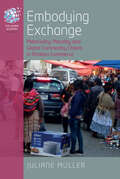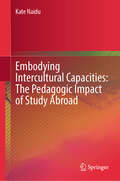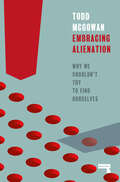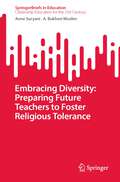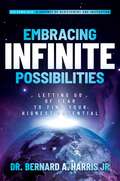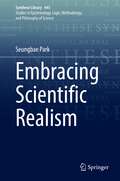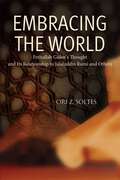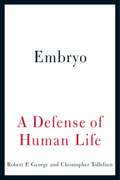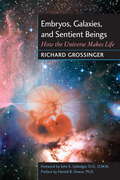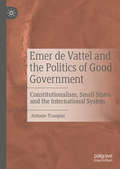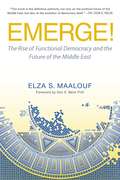- Table View
- List View
Embodiment and the Meaning of Life
by Jeff NoonanThe long tradition of pessimism in philosophy and poetry notoriously laments suffering caused by vulnerabilities of the human body. The most familiar and contemporary version is antinatalism, the view that it is wrong to bring sentient life into existence because birth inevitably produces suffering. Technotopianism, which stems from a similarly negative view of embodied limitations, claims that we should escape sickness and death through radical human-enhancement technologies. In Embodiment and the Meaning of Life Jeff Noonan presents pessimism and technotopianism as two sides of the same coin, as both begin from the premise that the limitations of embodied life are inherently negative. He argues that rather than rendering life pointless, the tragic failures that mark life are fundamental to the good of human existence. The necessary limitations of embodied being are challenges for each person to live well, not only for their own sake, but for the sake of the future of the human project. Meaning is not a given, Noonan suggests, but rather the product of labour upon ourselves, others, and the world. Meaningful labour is threatened equally by unjust social systems and runaway technological development that aims to replace human action, rather than liberate it. Calling on us to draw conceptual connections between finitude, embodiment, and the meaning of life, this book shows that seeking the common good is our most viable and materially realistic source of optimism about the future.
Embodiment, Dependence, and God (Elements in the Problems of God)
by Kevin TimpeThe significance of our physical bodies is an important topic in contemporary philosophy and theology. Reflection on the body often assumes, even if only implicitly, idealizations that obscure important facts about what it means for humans to be 'enfleshed.' This Element explores a number of ways that reflection on bodies in their concrete particularities is important. It begins with a consideration of why certain forms of idealization are philosophically problematic. It then explores how a number of features of bodies can reveal important truths about human nature, embodiment, and dependence. Careful reflection on the body raises important questions related to community and interdependence. The Element concludes by exploring the ethical demands we face given human embodiment. Among other results, this Element exposes the reader to the wide diversity of human embodiment and the nature of human dependence, encouraging meaningful theological reflection on aspects of the human condition.
Embodiment, Emotion, and Cognition
by Michelle MaieseBeginning with the view that human consciousness is essentially embodied and that the way we consciously experience the world is structured by our bodily dynamics and surroundings, the book argues that emotions are a fundamental manifestation of our embodiment, and play a crucial role in self-consciousness, moral evaluation, and social cognition.
Embodiment, Political Economy and Human Flourishing: An Embodied Cognition Approach to Economic Life
by Carsten Herrmann-Pillath Frédéric BassoThis book presents embodied economics as a foundational alternative to behavioral economics and other projects integrating economics and psychology inspired by the computational paradigm. The 20th century witnessed the disembodiment of economic models through the intensification of mathematization and formal abstraction in economics. Even proponents of an embodied approach to cognition, such as Hayek, paradoxically championed the abstract market order as a disembodied superhuman intelligence. In the wake of groundbreaking perspectives in cognitive and social sciences, which have helped to rethink the fundamental building blocks of economics, agency and institutions, this title takes a radical turn towards embodiment. Reinstating economics as political economy, embodied economics motivates a critique of capitalism based on the analysis of disembodiment through abstraction and reactivates key critical insights into the anthropology put forward by the young Marx about contemporary economics and its conceptualizations of money, property, and labor. Based on this analysis, the authors envision a concrete utopia for an economic order centered on human dignity and care for life on Earth. This book contributes to recent discussions about behavioral, experimental and neuroeconomics and addresses a transdisciplinary audience in the social and behavioral sciences, philosophy, and the humanities.
Embodiment, Relation, Community: A Continental Philosophy of Communication
by Garnet C. ButchartIn this volume, Garnet C. Butchart shows how human communication can be understood as embodied relations and not merely as a mechanical process of transmission. Expanding on contemporary philosophies of speech and language, self and other, and community and immunity, this book challenges many common assumptions, constructs, and problems of communication theory while offering compelling new resources for future study.Human communication has long been characterized as a problem of transmitting information, or the “outward” sharing of “inner thought” through mediated channels of exchange. Butchart questions that model and the various theories to which it gives rise. Drawing from the work of Giorgio Agamben, Roberto Esposito, Jean-Luc Nancy, and Jacques Lacan—thinkers who, along with Martin Heidegger and Michel Foucault, have critiqued the modern notion of a rational subject—Butchart shows that the subject is shaped by language rather than preformed, and that humans embody, and not just use, the signs and contexts of interaction that form what he calls a “communication community.”Accessibly written and engagingly researched, Embodiment, Relation, Community is relevant for researchers and advanced students of communication, cultural studies, translation, and rhetorical studies, especially those who work with a humanistic or interpretive paradigm.
Embodiment, Relation, Community: A Continental Philosophy of Communication
by Garnet C. ButchartIn this volume, Garnet C. Butchart shows how human communication can be understood as embodied relations and not merely as a mechanical process of transmission. Expanding on contemporary philosophies of speech and language, self and other, and community and immunity, this book challenges many common assumptions, constructs, and problems of communication theory while offering compelling new resources for future study.Human communication has long been characterized as a problem of transmitting information, or the “outward” sharing of “inner thought” through mediated channels of exchange. Butchart questions that model and the various theories to which it gives rise. Drawing from the work of Giorgio Agamben, Roberto Esposito, Jean-Luc Nancy, and Jacques Lacan—thinkers who, along with Martin Heidegger and Michel Foucault, have critiqued the modern notion of a rational subject—Butchart shows that the subject is shaped by language rather than preformed, and that humans embody, and not just use, the signs and contexts of interaction that form what he calls a “communication community.”Accessibly written and engagingly researched, Embodiment, Relation, Community is relevant for researchers and advanced students of communication, cultural studies, translation, and rhetorical studies, especially those who work with a humanistic or interpretive paradigm.
Embodiment: Phenomenological, Religious and Deconstructive Views on Living and Dying
by Ramona Fotiade David Jasper Olivier Salazar-FerrerThis book examines a number of landmark shifts in our account of the relationship between human and divine existence, as reflected through the perception of time and corporeal experience. Drawing together some of the best scholars in the field, this book provides a representative cross-section of influential trends in the philosophy of religion (e.g. phenomenology, existential thought, Biblical hermeneutics, deconstruction) that have shaped our understanding of the body in its profane and sacred dimensions as site of conflicting discourses on presence and absence, subjectivity and the death of the subject, mortality, resurrection and eternal life.
Embodying Art: How We See, Think, Feel, and Create
by Chiara CappellettoIn recent years, neuroscientists have made ambitious attempts to explain artistic processes and spectatorship through brain imaging techniques. But can brain science really unravel the workings of art? Is the brain in fact the site of aesthetic appreciation?Embodying Art recasts the relationship between neuroscience and aesthetics and calls for shifting the focus of inquiry from the brain itself to personal experience in the world. Chiara Cappelletto presents close readings of neuroscientific and philosophical scholarship as well as artworks and art criticism, identifying their epistemological premises and theoretical consequences. She critiques neuroaesthetic reductionism and its assumptions about a mind/body divide, arguing that the brain is embodied and embedded in affective, cultural, and historical milieus.Cappelletto considers understandings of the human brain encompassing scientific, philosophical, and visual and performance arts discourses. She examines how neuroaesthetics has constructed its field of study, exploring the ways digital renderings and scientific data have been used to produce the brain as a cultural and visual object. Tracing the intertwined histories of brain science and aesthetic theory, Embodying Art offers a strikingly original and profound philosophical account of the human brain as a living artifact.
Embodying Data: Chinese Aesthetics, Interactive Visualization and Gaming Technologies
by Qi LiThis book investigates a new interactive data visualisation concept that employs traditional Chinese aesthetics as a basis for exploring contemporary digital technological contexts. It outlines the aesthetic approach, which draws on non-Western aesthetic concepts, specifically the Yijing and Taoist cosmological principles, and discusses the development of data-based digital practices within a theoretical framework that combines traditional Taoist ideas with the digital humanities. The book also offers a critique of the Western aesthetics underpinning data visualisation, in particular the Kantian sublime, which prioritises the experience of power over the natural world viewed at a distance. Taoist philosophy, in contrast, highlights the integration of the surface of the body and the surface of nature as a Taoist body, rather than promoting an opposition of mind and body. The book then explores the transformational potential between the human body and technology, particularly in creating an aesthetic approach spanning traditional Chinese aesthetics and gesture-based technology. Representing a valuable contribution to the digital humanities, the book helps readers understand data-based artistic practices, while also bringing the ideas of traditional Chinese aesthetics to Western audiences. In addition, it will be of interest to practitioners in the fields of digital art and data visualisation seeking new models.
Embodying Difference: Critical Phenomenology and Narratives of Disability, Race, and Sexuality
by Simon DickelThis book explores how phenomenological ideas about embodiment, perception, and lived experience are discussed within disability studies, critical race theory, and queer studies. Building on these disciplines, it offers readings of memoirs and novels that address the consequences of stigmatization and the bodily dimensions of social differences. The texts include Robert F. Murphy’s The Body Silent, Simi Linton’s My Body Politic, Rod Michalko’s The Two-in-One: Walking with Smokie, Walking with Blindness, three memoirs by Stephen Kuusisto, Vincent O. Carter’s The Bern Book, as well as two novels, Matthew Griffin’s Hide and Armistead Maupin’s Maybe the Moon. All of the texts discussed in this book negotiate the significance of bodily and perceptual habits, the influence of language and culture on embodiment, the importance of relationality and community, the severe effects of misrecognition, and the possibilities of emancipation and social recognition. Hence, they are read as pioneering contributions to the emerging field of critical phenomenology.
Embodying Exchange: Materiality, Morality and Global Commodity Chains in Andean Commerce (The Human Economy #11)
by Juliane MüllerAddressing the infrastructural, legal and moral complexities in contemporary world trade, this book uses an ethnographic analysis of the interface of multinational brand manufacturers and popular traders in the Bolivian Andes. It offers a situated account of traders’ understanding of regulatory principles, and traces commercial dynamics beyond the limits of what we define as economic. It aims to humanize our understanding of the economy by grounding it in everyday life and morality.
Embodying Intercultural Capacities: The Pedagogic Impact of Study Abroad
by Kate NaiduThis book examines the extent to which in-country education contributes to the development of intercultural capacities among students and investigates how this occurs. It examines the experiences of Australian university students participating in educational programs in Indonesia and critiques and extends notions of interculturality. The potential development of intercultural capacities is explored in relation to four key themes: pedagogy, temporality, home, and culture. The book demonstrates that interculturalisation is not an automatic or guaranteed result of simply being ‘immersed’ in-country, but rather involves an array of pedagogic processes (involving both human and non-human actors). It outlines the temporal dimensions of in-country education, examining the experience as part of a broader trajectory, involving significant moments, and a range of engagements with diverse temporal rhythms. The book concludes by exploring how students’ understandings of ‘culture’ and ‘cultural difference’ impact the way in which the study-abroad experience is navigated. Readers will gain a deepened understanding of how intercultural capacities develop, which can be applied to other educational contexts including schools, as well as corporate and not-for-profit settings. Those interested in sociology, particularly Bourdieusian analysis, will also benefit from this empirical application (and extension) of the notion of habitus in the context of student mobility. “This is a well conceptualized and beautifully written book that explores how study abroad programs can play an important role in equipping young people to navigate the super-diversity that has now become a critical feature of societies around the world. It shows how such programs have the potential to enhance intercultural capacities, especially when crafted in ways that are thoughtfully fashioned and carefully enacted.” — Fazal Rizvi, University of Melbourne Australia
Embracing Alienation: Why We Shouldnt Try to Find Ourselves
by Todd McgowanThe left views alienation as something to be resisted or overcome, but could it actually form the basis of our emancipation?In Embracing Alienation, Todd McGowan offers a completely different take on alienation, claiming that the effort to overcome it is not a radical response to the current state of things but a failure to see the constitutive power of alienation for all of us. Instead of trying to overcome alienation and accede to an unalienated existence, it argues, we should instead redeem alienation as an existential and political program.Engaging with Shakespeare&’s great tragedies, contemporary films such as Don&’t Worry Darling, and even what occurs on a public bus, as well as thinkers such as Descartes, Hegel, and Marx, McGowan provides a concrete elaboration of how alienation frees people from their situation. Relying on the tradition of dialectical thought and psychoanalytic theory, Embracing Alienation reveals a new way of conceiving how we measure progress — or even if progress should be the aim at all.
Embracing Diversity: Preparing Future Teachers to Foster Religious Tolerance (SpringerBriefs in Education)
by Anne Suryani A. Bukhori MuslimThis book presents a detailed discussion of Indonesian future teachers’ experience of religious diversity, tolerance and intolerance, their level of intellectual humility, and intentions to foster religious tolerance. Drawing from large-scale mixed methods research conducted in Indonesian universities involving over one thousand three hundred future teachers from diverse religious backgrounds, this book demonstrates that religion and religious beliefs can, and do, shape the way future teachers view their teaching practices and pedagogies. The book sheds light into the under-researched yet prominent issue of integrating tolerance into teacher education preparation. It is set in the largest Muslim-majority country in the world which, in recent years, has seen a gradual degradation of secularity while religion becomes more dominant across all levels and sectors of society. This novel and timely book is of interest to researchers, scholars, and students in religious studies, education, social sciences, and Asian studies, as well as anyone interested in the interplay between religion and education in the 21st century.
Embracing Hope: On Freedom, Responsibility & the Meaning of Life
by Viktor E. FranklA highly anticipated, rediscovered collection from Viktor Frankl, published for the first time in the United States, exploring freedom, responsibility, and how we can draw meaning from the temporary nature of our livesFrom the bestselling author of Man's Search for Meaning, which has sold over 18 million copiesThe Library of Congress lists Man&’s Search for Meaning as one of the ten most influential books in history. Scientists and artists, politicians and celebrities regularly cite Frankl as one of the most important authors every person should read. Now, there is another book for his devoted fans to add to their collections.Published here for the first time in the United States, Embracing Hope continues Frankl&’s enduring life&’s work and provides even more lessons for those searching for meaning and purpose. It&’s made up of four distinct pieces from Frankl on different themes - all uniting around the idea that we should remain open to life even when we have been subjected to appalling injustice, and even when we are faced with our own mortality and the brief nature of our lives. At a time of global suffering where so many are searching for hope and meaning, Frankl&’s work seems more relevant and more important than ever.Whether you're a devoted follower of Frankl's work or a newcomer seeking to enrich your understanding of life's purpose, this book promises a captivating journey that will leave you pondering its teachings long after you've turned the final page.Just imagine what would happen, what life would look like, if there were no death. Imagine what it would be like if you could postpone anything and everything, if you could put it off for eternity. You wouldn't have to do anything today or tomorrow. Everything could just as easily be done next week, next month, next year, in a decade, in 100 or 1,000 years. Only in the face of death, only under pressure from the finiteness, the temporal limitation of human existence, is there any point in going about our business, and not only in going about our business, but in experiencing life, and not only in experiencing life but also in loving someone, and even in enduring and surviving something that is inflicted on us.
Embracing Infinite Possibilities: Letting Go of Fear to Find Your Highest Potential
by Dr. Bernard A. Harris JrDr. Bernard Harris shares his journey, and an honest discussion of his struggles, ambitions, hopes and dreams, as a testimony to the voyage that we all face with a desire to discover the power from within.All of us have to deal with external challenges at some point in our lives. Liberation comes when you discover just how unimportant these things really are. Then you will no longer see the world around you as hostile and unforgiving. This reality will free you to be who you really are. There is great power with this realization! Self-endowed power that releases you from the burden of self-doubt. There is no greater power in the world, except that of God. This is, in fact, the truth that God wants for each of us. The realization of our own strength, that is, we are an integral part of something greater than ourselves. One of Harris&’s lifelong goals is to instill inspiration as well as aspiration in people. Embracing Infinite Possibilities looks to build on these ideas by serving as a roadmap to discover the power within each of us. If we are students of the universe, it is clear to me that each of us must find this power within to find our own way and in our own time—some through the experiences of life, some by reading, others by observing, being taught or through self-study. Harris encourages the reader to find their own path. As a companion to his first book, Dream Walker, Embracing Infinite Possibilities will open their mind to the infinite possibilities of life, instilling hope in those who have yet to discover their own power.
Embracing Prodigals: Overcoming Authoritative Religion by Embodying Jesus' Nurturing Grace
by John SandersDo you wonder why some people you know hold theological and political views that blow your mind but they find quite reasonable? Today, Christians are at odds over how to understand the Bible, atonement, and salvation of non-Christians. They are also polarized over issues such as same-gender marriage, income inequality, and health care. Two social science models, Nurturant and Authoritative, explain this divide. Values are at the heart of our disagreements. Nurturants prize empathy and cooperation while Authoritatives cherish obedience to law and order. Each group has distinct core values and these lead them to embrace different theological, moral, and political views. This book explains the divide and makes the case that Jesus embodied the Nurturant way of life. He modeled empathy, grace, forgiveness, and care for those beyond his own tribe. The Nurturant and Authoritative approaches have competed for thousands of years but contemporary research shows that the Nurturant way of life produces better mental and spiritual health as well as superior communities in which to live.
Embracing Scientific Realism (Synthese Library #445)
by Seungbae ParkThis book provides philosophers of science with new theoretical resources for making their own contributions to the scientific realism debate. Readers will encounter old and new arguments for and against scientific realism. They will also be given useful tips for how to provide influential formulations of scientific realism and antirealism. Finally, they will see how scientific realism relates to scientific progress, scientific understanding, mathematical realism, and scientific practice.
Embracing the Ordinary
by Michael FoleyNothing is less known than what seems familiar. The ordinary is always the exceptional in disguise. Everything happens when nothing is happening. It has always been difficult to appreciate everyday life, often devalued as dreary, banal and burdensome, and never more so than in a culture besotted with fantasy, celebrity and glamour. Yet many writers and artists have celebrated the ordinary, and many philosophers have offered insights into the rewards of paying attention to the here and now. With characteristic wit and earthiness, Michael Foley - author of bestseller The Age of Absurdity - draws on the work of 'champions of the ordinary', such as James Joyce and Marcel Proust, to encourage delight in the oddity of the everyday world. With astute observation and subversive glee, Foley brings fresh insights to such things as the banality of everyday speech, the complexity of everyday psychology, the ludicrousness of snobbery, love and sex, and the pleasures of the everyday environments of city, office and home. It is all more fascinating, comical and mysterious than you think. Praise for The Age of Absurdity 'Michael Foley's entertaining, intelligent book may just help you get over yourself. . . Absurdly readable' Observer 'Achingly funny and wise . . . vastly entertaining' Daily Mail
Embracing the World: Fethullah Gulen's Thought and Its Relationship with Jelaluddin Rumi and Others
by Ori Z. SoltesThis book is not a comprehensive study of Rumi and Gülen, but it seeks to explore the places where the thought of the one is echoed in the thinking of the other, either overtly or indirectly—and to note ways in which the opposite is true: that Gülen diverges from Rumi. The book is also seeking to suggest some of the larger contexts in which the thinking of both resides. Given the wide-ranging aspects of their respective writings, it should not be surprising if, minimally, we can find important foundation stones in both philosophy and theology in the edifices that they each construct.
Embryo
by Robert P. George Christopher TollefsenGeorge (jurisprudence and American ideals and institutions, Princeton U. ) is a member of the President's Council on Bioethics, so readers who think that august body is benefiting the world may be interested to learn about the murk its house is built on. He and Tollefsen (philosophy, U. of South Carolina) clearly have no competence to discuss the biology of human development or the theology of life and death. That is just fine, however, because their argument is all about politics and power. Annotati...
Embryogenesis
by Richard Grossinger Phoebe Gloeckner Jillian O'MalleyEmbryogenesis is an unusual book in that it brings together a highly illustrated, practical embryology book in simple language, perfect for health practitioners, with a fascinating read on the history and philosophy of biological science. It discusses the various stages of embryonic development (meiosis, fertilization, blastula development, and gastrulation, and then the embryology of each of the human organs and organ systems in detail). It puts each of them in context, both in terms of its phylogeny: the evolutionary trajectory of cell-organized systems on Earth, and its ontogeny: the formation of individual organisms in the modern world. There are 24 color plates, many of them commissioned uniquely for this volume, and several hundred black and white illustrations. The book is 950 pages hardcover, 8-1/2 by 10.Chapters include: The Original Earth; The Materials of Life; The First Beings; The Cell; The Genetic Code; Sperm and Egg; Fertilization; The Blastula; Gastrulation; Morphogenesis; Biological Fields; Chaos, Fractals, and Deep Structure; Ontogeny and Phylogeny; and Biotechnology. The Origin of the Nervous System; The Evolution of Intelligence; Neurulation and the Human Brain; Organogenesis; The Musculoskeletal and Hematopoietic Systems; Mind; The Origin of Sexuality and Gender. Healing; Transsexuality, Intersexuality, and the Cultural Basis of Gender; Self and Desire; Cosmogenesis and Mortality
Embryos, Galaxies, and Sentient Beings
by John E. Upledger Richard Grossinger Harold B. DowseWhy is the universe conscious? What kindles mind inside matter? Why do fundamentalist sciences and religions never ask these questions? This sequel to Embryogenesis deals with the theoretical issues brought up by Embryogenesis, including: the relationship between thermodynamics/entropy and the emergence of life; a speculative set of embryogenic principles for all creatures on all planets in the cosmos; an explanation and critique of Intelligent Design and a proposal for a more dynamic psychospiritual theory of creature development; a series of alternatives to genetic determinism; a discussion of the relationship between consciousness and matter; an interjection of 9/11 (which occurred during the writing of this book); and many other topics. Chapters include: What is Life?: Evolution, Thermodynamics, and Complexity; Is There a Plan?: Creationism, Cultural Relativism, and Paraphysics; Biogenesis and Cosmogenesis: Cells, Genes, and Planets; The Principles of Biological Design: Physical Forces in Nature; The Dynamics of the Biosphere: Deep Time and Space; The Limits of Genetic Determinism: Dimensionless Epigenetic Landscapes; Topokinesis: Physical Forces in Development; Tissue Motifs and Body Plans: Coordinating Form; The Primordial Field: Metabiology and The Molecular Apparatus; Meaning and Destiny: The Relation of Consciousness to Matter
Emer de Vattel and the Politics of Good Government: Constitutionalism, Small States and the International System
by Antonio TrampusThis book explores the history of the international order in the eighteenth and nineteenth century through a new study of Emer de Vattel’s Droit des gens (1758). Drawing on unpublished sources from European archives and libraries, the book offers an in-depth account of the reception of Vattel’s chief work. Vattel’s focus on the myth of good government became a strong argument for republicanism, the survival of small states, drafting constitutions and reform projects and fighting everyday battles for freedom in different geographical, linguistic and social contexts. The book complicates the picture of Vattel’s enduring success and usefulness, showing too how the work was published and translated to criticize and denounce the dangerousness of these ideas. In doing so, it opens up new avenues of research beyond histories of international law, political and economic thought.
Emerge!
by Elza S. MaaloufIn the Middle East, turmoil has spread quickly. Oppression, inequality, and violence have been keyed in to the very makeup of its society. But what causes a culture to emerge and prosper or stagnate and fail? How can the people take charge of their own inalienable rights to growth, freedom, and life - to keep from backsliding into the grasp of old, unhealthy ideologies and meet their need for ascendance? In Elza Maalouf's groundbreaking new book Emerge! The Rise of Functional Democracy in the Middle East, we are introduced to a new paradigm for governance based on Clare Graves' theory of Spiral Dynamics. Maalouf, the founder of the Center for Human Emergence and the Build Palestine Initiative, is an expert on the application of Spiral Dynamics in the Middle East. By placing democracy in an evolutionary, values-system context that is specific to unique, Middle Eastern characteristics, Emerge pioneers the foundations for necessary change. Where the West's approach to conflict resolution has failed due to lack of memetic understanding, Maalouf's framework for decoding the complexities of the Middle East succeeds. By weaving together the threads that make up the pattern of each culture, Emerge shows the crucial role memes play in creating a system of governance that truly fits. Not only does Emerge ask us to seek understanding before we structure and create, it shows us the necessity of teaching our youth to build their own sustainable, indigenous constructs.
